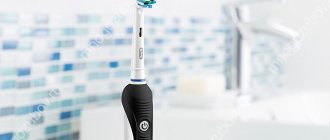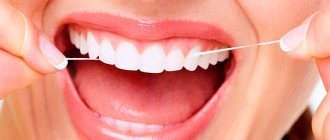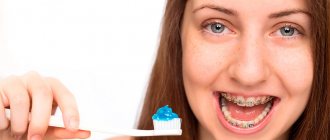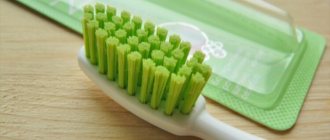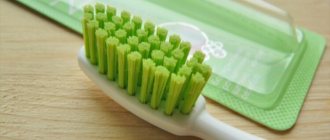A toothbrush is a device that every person has for personal use today. This is an indisputable fact and an absolutely integral attribute, without which it is quite difficult to imagine a comfortable life. Perhaps today, even every child understands that timely and systematic brushing of teeth is the key to oral health. Accordingly, it is quite obvious that the main cleaning tool - a brush - must be of high quality, in good condition, and also correctly selected.
Not only the quality of teeth cleaning, but also their immediate health and the condition of the enamel depends on the toothbrush used. Therefore, it is very important to know how to choose the right brush and what nuances to pay attention to during the selection process. But the market for such devices today is replete with not only brand names, but also types of devices, because brushes have long been not simple, but electric. And today we will try to figure out which toothbrush is better, electric or regular.
Regular toothbrush
Of course, the most common brushes today are the most common devices. Obviously, this trend is primarily observed due to the significantly lower cost compared to electric toothbrushes. However, simple brushes are presented in such an assortment that it often becomes very difficult for the average person to make a choice, because the number of parameters and characteristics inherent in brushes is almost endless. Let's understand the main aspects that you should pay attention to when choosing the best toothbrush for your individual use.
About noise during operation of an individual tool
You should definitely pay attention to this indicator. Ultrasonic brushes are considered the quietest.
On a note. It doesn't matter which electric model you buy. It is important, when treating the surface of the teeth and the oral cavity, not to harm the enamel or damage the soft tissues.
Electric toothbrush.
When working with an electric tool, you must follow a number of rules:
- There is no point in pressing on the body of the product, applying great force, thereby provoking the occurrence of enamel erosion. When purchasing a particular model, make sure it has a pressure sensor. This will help you adjust the force with which you need to press the brush.
- Treatment of the mucous membrane and gums should be performed with a special attachment that acts as a massage tool.
- In case of inflammatory processes in the oral cavity, you should stop using an electric brush for a while.
Hardness level
One of the fundamental and most important parameters of toothbrushes is the level (degree) of hardness. It is important to emphasize that this factor is important, regardless of whether you are using an electric toothbrush or a regular one.
There are several main degrees of rigidity:
- Very soft. Intended for use by children with baby teeth. These brushes are also an ideal choice for adults suffering from gum or dental disease. If you have periodontitis or increased enamel sensitivity, this choice will be ideal;
- Soft. Such bristles will be an excellent assistant when used by people suffering from bleeding gums. In addition, doctors also recommend that pregnant and breastfeeding women use brushes with soft bristles. It is important to understand that you need to brush your teeth correctly, without pressing too hard;
- Medium level of hardness. The real standard, the most commonly used type of firmness, which is popular mainly among adults. If you consider your oral cavity to be completely or relatively healthy, choosing a medium-hard brush will be rational for you;
- Tough. Doctors recommend brushes with hard bristles only to those who regularly smoke or drink coffee, as well as to people exposed to heavy plaque. In other cases, use is not recommended;
- Very tough. This type of bristles on brushes is recommended by experts for cleaning removable dentures, as well as in cases of using dental braces and plates. It is these brushes that will allow you to clean the oral cavity with the highest quality and completeness.
Which models are the best?
If the question of which toothbrush is better - a regular or an electric one - has been resolved, then you need to choose the best model. When choosing a traditional brush, models with the following parameters are suitable:
- polymer bristles with antistatic properties,
- rounded top;
- silicone inserts on the handle;
- flexible connection between handle and head.
You should choose products with bristles whose degree of rigidity corresponds to the condition of the gums and teeth. The best option for an electric brush would be a product with a powerful battery that has replaceable attachments. The most popular models for both children and adults are products under the Oral B and Braun brands.
Variety: therapeutic and prophylactic toothbrush
These brushes differ in that the bristles on them are located at different levels by default. In addition, it is also noted that such products often use villi of different hardness, this makes it possible to significantly better clean the space between the teeth, as well as get rid of plaque and food debris almost completely.
Often, therapeutic and prophylactic brushes are distinguished by the presence of rubberized or silicone inserts. They will allow you to massage your gums and tongue, as well as additionally polish the surface of your teeth.
Doctors recommend using such brushes for people with weakened gums, but a therapeutic and prophylactic brush will be the ideal choice for most people, even those who do not have problems with gums.
How to brush your teeth with a regular brush?
Hold the brush at a 45° angle to the gum line
. Bacteria and plaque usually hide in the sulcus of the gums. To get rid of them more effectively, the brush head should be slightly tilted towards the furrow. This gives an angle of 45°.
Brush your teeth using short, circular, back-and-forth sweeping movements.
. Not moving up and down - this is a common mistake. Don't press too hard on your teeth; this won't make them cleaner, but it will increase the risk of your teeth becoming hypersensitive and your gums bleeding. Here is an example video with the correct technique.
First, pay attention to the outer surface of the teeth, then to the inner, then to the chewing surfaces. To thoroughly clean the inner surface of the front teeth (a place that is difficult to reach, so do it separately, after chewing surfaces), change the angle and movements: hold the brush vertically and make forward-down movements - in this case they will be correct. Finally, clean your tongue. Even if there is no special scraper, the brush will cope with this quite well.
Working principle of an electric toothbrush
Since their appearance in the 60s until today, electric brushes have come a long way. And in the form in which we have the opportunity to observe and use them today, they work according to the following principle:
- The brush handle contains a battery or battery that supplies power to the moving element.
- The moving element begins to rotate when the corresponding button is pressed.
- The rotational movements of the element are transmitted to the toothbrush head, on which there is a round tip with brush bristles.
- The tip begins to rotate.
The main advantage of such a brush is that after setting the tip in motion, the user only has to move the brush from tooth to tooth with his hand - the brush does all the rest of the work on its own.
It is important to note that there is a second type of electric brushes, which has a slightly different operating principle. We are talking about ultrasonic electric brushes that work according to the following scheme:
- A battery or battery is inserted into the handle of the brush, as well as a special sound element.
- When you press the power button, the element begins to vibrate.
- Due to the reproduced vibrations, the fibers on the nozzle begin to move.
When using ultrasonic brushes, the user needs to brush their teeth themselves, however, due to the vibrations of the brush bristles, the cleaning procedure has a higher efficiency.
How does it work
The operating principle of an electric brush is based on the use of electricity. The power source provides pulses that activate the cleaning head. Additional dynamics are created that promote effective cleansing of the enamel.
The operation of an electric brush depends on the type of mechanism, including:
- Mechanical - the procedure is carried out due to the rotation of dynamic movements of the head. Thanks to back-and-forth maneuvers, the bristles remove plaque.
- Sound - work is performed due to sound vibrations generated by a generator. It is believed that this operating principle does not damage tooth enamel as much.
- Ultrasonic – works in a similar way to sound. The radius of propagation of sound vibrations is 3 mm. Cleaning is carried out more thoroughly, dirt is removed from hard-to-reach places.
Advantages of electric toothbrushes over regular ones
Of course, electric brushes also have a whole list of obvious advantages:
- Soft plaque is removed much easier than with a regular brush and in large volumes;
- Attracts children and makes them want to systematically brush their teeth;
- Ease of use;
- Ease of transportation.
Perhaps the only drawback of an electric toothbrush is its cost, which can reach very significant levels. However, it is quite possible to find an excellent option for 15-20 dollars, which can be used for more than one year.
Operating principle and activation method
Just a few decades ago, cleaning your mouth, even with a toothbrush, required your own efforts. Nowadays, manufacturers offer models that require only guiding and holding the brush in the correct position. However, there is a large selection of toothbrushes with different specific actions:
- A manual toothbrush is a standard model that can have bristles of varying stiffness. It is a handle with a cleaning head with bristles. The brush must be controlled manually.
- The ionic brush has a special rod coated with titanium dioxide. This metal releases electrons that neutralize the acid and destroy harmful bacteria. The powerful ionic flow allows you to use the brush without toothpaste.
- An electric toothbrush works through a combination of pulsing and rotating movements that remove plaque and whiten the surface of the teeth, clean the tongue and gums. The set includes various attachments that can be used at different speeds.
- The ultrasonic device has a therapeutic effect on the gums, removes tartar and stops inflammatory processes. Ultrasonic action destroys microbes and removes plaque.
The ideal option for daily cleaning of healthy teeth is an electric toothbrush, which has a high level of efficiency and a significant cost. You can also clean your teeth efficiently using a standard manual brush, but to use it effectively, you need to clarify the basic rules of hygiene.
How to choose an electric brush
Let us also note the nuances of choosing a device such as an electric toothbrush, because for the domestic buyer such a gadget is a kind of innovation, and if you decide to use it for the first time, questions and difficulties may arise during the selection process. When purchasing, you should pay attention to the following factors:
- Power source - it can be of two types: battery and accumulator. The rechargeable option is ideal because it allows you to save on the purchase of new batteries by charging from the standard station included in the kit. It’s easy to guess that the power of battery brushes is slightly higher. And greater power directly leads to better cleaning ability;
- The technology used for moving the nozzle is the number of movements that the brush head “can” make. This can be regular rotation in one direction, in two directions, or in two directions together with pulsating movements. Such technologies are called 1-D, 2-D, and, accordingly, 3-D;
- The number of attachments included - as you know, a regular toothbrush needs to be changed periodically. Experts recommend doing this once a month. As for electric brushes, the attachments on such devices change. Therefore, the issue of having additional attachments is important;
- Additional functionality - many manufacturers are trying to expand the functionality of their devices by introducing various innovations into them. They begin with additional modes for caring for gums and teeth, and end with interfaces such as Bluetooth, for example. Of course, you have to pay for such conveniences, so such functionality can be called a small advantage, and not an urgent need.
Advantages and disadvantages of electric
Only a small percentage of people brush their teeth correctly.
For your information! Many people do not take the required amount of time when caring for their oral cavity due to rush, especially in the morning.
pros
Electric models have the following advantages:
- Brushing your teeth correctly with this brush is possible even for those who would never be able to do it correctly with a regular one. Small children, old people and people with disabilities will be able to brush their teeth efficiently with them.
- This model allows you to effectively fight plaque. It removes soft dental deposits and prevents the formation of hard tartar.
- These devices require less toothpaste . This allows you to save on her purchases.
- Thanks to the presence of pressure sensors in modern models, the user will not be able to damage the enamel, gums and mucous membranes in the mouth.
- If the kit includes individual attachments, then all family members can use the device.
- Most models have a built-in timer , this allows you to control the procedure time.
- The kit includes attachments for cleaning the tongue ; their use ensures the best hygiene for the oral cavity. A special attachment can be used to polish the surface of tooth enamel.
- Electric brushes allow you to clean even the most difficult to reach places well .
Minuses
When electrical models are used correctly, no harm to teeth is detected.
Remember! There are some restrictions on their use. These include:
- One of the main disadvantages limiting the widespread use of this device is its high price .
- The need for recharging , in order for the brush to work, batteries or a rechargeable battery are used. You need to monitor the level of charge of the device. This is not always convenient, especially when traveling.
- Constant replacement of expensive attachments is necessary
- There is no way to check when purchasing whether this model is suitable.
- These devices are contraindicated for people with thin enamel and weak gums . They can be easily damaged and the enamel can be erased.
- The use of these devices damages orthopedic structures installed in the mouth (fixed dentures, veneers, crowns, implants).
- It is not recommended to use if hard tartar appears.
- In patients with caries at the white spot stage and wedge-shaped defects, the use of these devices is contraindicated, as they contribute to progression.
- Not recommended for patients with diseases of the cardiovascular system. Their use is prohibited with installed pacemakers.
- These devices should not be used by children under three years of age.
It is more difficult to protect the head of an electric brush from the growth of microorganisms; you cannot simply take it and boil it.
Which toothbrush is better: electric or regular?
So we have come to the most important question, which is posed by many modern people who are thinking about switching to electrical devices, but have not yet made a final decision. Of course, an electric device is more comfortable to use. In addition, it is marked by a noticeably higher efficiency and higher quality work results. That is why we can safely say that an electric toothbrush is superior in its capabilities to a regular one.
However, there is one parameter in which the innovative device is inferior to the “good old” brush - price. It is quite obvious that the cost of a regular brush is much more acceptable.
As for the need to periodically replace brushes, of course, no one has canceled it. However, replacement heads for most popular electric brushes today cost about the same as a new, quality regular toothbrush. In this aspect, both types of products are equal.
In general, as we have already said, buying an advanced electric brush is a completely rational decision, but whether it makes sense to give preference to an electric toothbrush instead of a regular one is up to you to decide.
Electrical means
Today, most people prefer to use electrical devices that can be powered by mains or batteries. Dentists also recommend using such products, since with their help you can thoroughly clean all places in the mouth that are difficult to access.
- You can change the nozzles.
- Does not have a negative effect on the gums.
- Cleans enamel well.
- Massages the gums and prevents their inflammation.
- You can clean your tongue.
- Durability.
- The cleaning procedure itself is pleasant.
Sometimes an electrical device can clean by using sound waves. They are divided into:
In the first case, a piezoelectric crystal is used for cleaning, which creates small vibrations of the pile. This helps to clean teeth efficiently and quickly from even the smallest particles of food and plaque. Such devices help whiten enamel, destroy microbes in the mouth, and the paste penetrates the enamel structure.
Ionic devices contain titanium dioxide in the handle. With its help, polarity is created between plaque and the tooth, which allows it to be better cleaned. With constant use of the device, the condition of the gums improves and the sensitivity of the enamel decreases.
Contraindications
In addition to their advantages, brushes have contraindications, in the presence of which their use should be abandoned. You should refrain from using them if you have the following diseases:
- Enamel aplasia.
- Caries.
- Stomatitis.
- Tooth mobility.
- Recessed gums.
- Neoplasms in the mouth.
- Periodontal disease.
Read also: Why does a child grind his teeth?
Those who smoke should treat such devices with caution; they can irritate the mucous membranes in the mouth, increasing the negative effects of nicotine.
Is this justified?
To date, many different, but similar in essence, studies have been carried out. The effectiveness of individual oral hygiene using a regular manual toothbrush is lower than when using an electric one. But, nevertheless, after learning the correct technique from a dentist, a higher quality effect is achieved than simply from an electric one.
Based on a brief description of the research results, it is clear that the key factor is not the brush, but the ability to use it. It is not difficult to obtain the necessary skills; they are understandable to everyone, intuitively.
Next, we will offer several methods of oral care.
Regular brush
The use of the products is widespread. It has characteristics, the main one of which is the hardness of the pile. Those who have a lot of plaque on their teeth should give preference to a product with hard bristles. But it must be applied carefully so as not to damage the enamel.
Typically, brushes with medium bristles are used. They are often used by people with healthy teeth and gums.
Such devices can also differ in the number of beams and shape. All these points affect the quality of cleaning. Based on these characteristics, brushes are also divided into:
- Preventive. Can be bought at any store. They have piles of different lengths and hardness.
- Hygienic. The length of the beams and their rigidity are the same. Usually intended for children.
- Special. Can be used for cleaning briquettes or implants. Sold in pharmacies.
The use of conventional devices should also be abandoned in the following cases:
- Thin enamel that can be damaged even by soft bristles.
- Inflammation of the gums.

